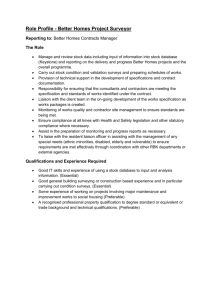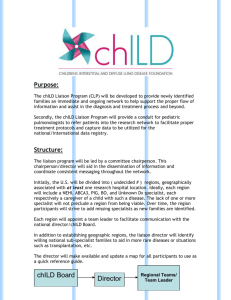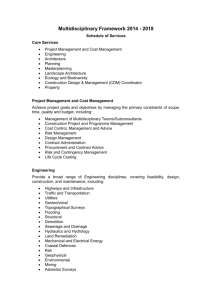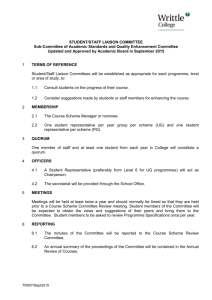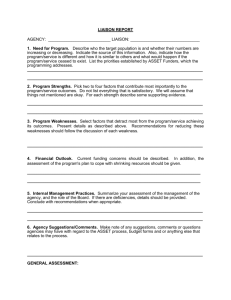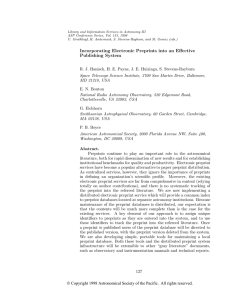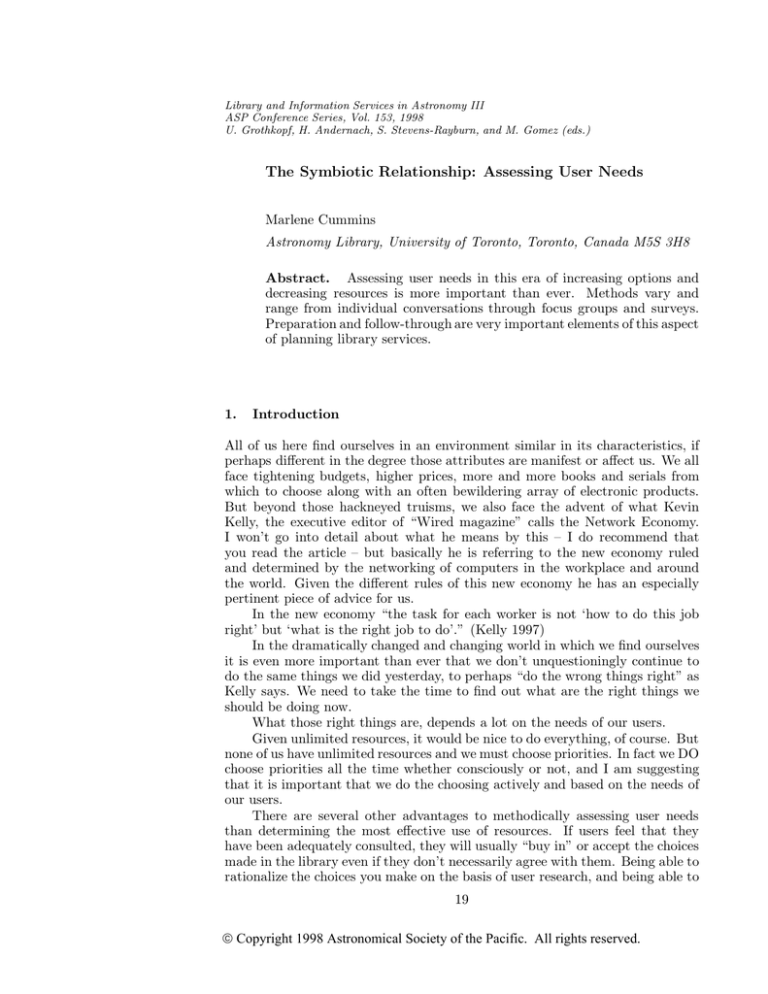
Library and Information Services in Astronomy III
ASP Conference Series, Vol. 153, 1998
U. Grothkopf, H. Andernach, S. Stevens-Rayburn, and M. Gomez (eds.)
The Symbiotic Relationship: Assessing User Needs
Marlene Cummins
Astronomy Library, University of Toronto, Toronto, Canada M5S 3H8
Abstract. Assessing user needs in this era of increasing options and
decreasing resources is more important than ever. Methods vary and
range from individual conversations through focus groups and surveys.
Preparation and follow-through are very important elements of this aspect
of planning library services.
1.
Introduction
All of us here find ourselves in an environment similar in its characteristics, if
perhaps different in the degree those attributes are manifest or affect us. We all
face tightening budgets, higher prices, more and more books and serials from
which to choose along with an often bewildering array of electronic products.
But beyond those hackneyed truisms, we also face the advent of what Kevin
Kelly, the executive editor of “Wired magazine” calls the Network Economy.
I won’t go into detail about what he means by this – I do recommend that
you read the article – but basically he is referring to the new economy ruled
and determined by the networking of computers in the workplace and around
the world. Given the different rules of this new economy he has an especially
pertinent piece of advice for us.
In the new economy “the task for each worker is not ‘how to do this job
right’ but ‘what is the right job to do’.” (Kelly 1997)
In the dramatically changed and changing world in which we find ourselves
it is even more important than ever that we don’t unquestioningly continue to
do the same things we did yesterday, to perhaps “do the wrong things right” as
Kelly says. We need to take the time to find out what are the right things we
should be doing now.
What those right things are, depends a lot on the needs of our users.
Given unlimited resources, it would be nice to do everything, of course. But
none of us have unlimited resources and we must choose priorities. In fact we DO
choose priorities all the time whether consciously or not, and I am suggesting
that it is important that we do the choosing actively and based on the needs of
our users.
There are several other advantages to methodically assessing user needs
than determining the most effective use of resources. If users feel that they
have been adequately consulted, they will usually “buy in” or accept the choices
made in the library even if they don’t necessarily agree with them. Being able to
rationalize the choices you make on the basis of user research, and being able to
19
Copyright 1998 Astronomical Society of the Pacific. All rights reserved.
20
M. Cummins
articulate the rationale will help you deal with those users whose current needs
are not fully satisfied. It also will help you defend your budget.
For example, a few years ago, in doing an analysis of the way we spend
our time, I discovered that a large part of it is taken up collecting and tracking
preprints. Furthermore I had learned through a survey that preprints are very
important to students and post-docs but less important to senior faculty (at my
institution, at least). I ended up successfully using this information to avoid a
staff cut which was proposed by some of the senior staff who hadn’t realized how
important preprints were to some other members of the department.
2.
Discover the options available
The first step in this exercise is to find out the possibilities; to find out as much
as possible about all the various products that we can buy, the services that we
can render and the electronic options we can offer to our users. To that end
joining listservs, reading articles (paper and electronic), talking to vendors and
attending conferences are all critical. In doing this you will come across things
that your users don’t even know they need because they don’t know that they
exist or don’t know their potential. It is part of our role to teach ourselves and
to teach them.
In your consideration of possibilities, don’t forget serendipity. Serendipity
is the act of making a happy discovery by accident, in our context usually by
browsing the literature. There are some kinds of bibliographic research that
mitigate against serendipity and it is good to be aware of them and to offer
compensating opportunities.
3.
Determine your mandates, goals and who are your users
The mandate of your library may be perfectly obvious to some of you, but to
others of you it may be a bit murky. To most effectively deploy our resources
it is essential to know the goal(s) of your organization, both your library and
your parent or funding institution. For example, many observatories believe that
public education is a core part of their mandate. A university would have both
research and teaching as goals. Some colleges however have strong research and
graduate programmes while others focus primarily on teaching undergraduates.
Some institutions focus on preservation and archiving, others on communicating
with others through preprints and interactive web sites.
You also need to determine which group of users it is your primary purpose
to serve. Perhaps there is more than one primary group. What other groups do
you serve, how do they rank and how far behind your primary group are they?
These groups might include research staff, technical staff, graduate students,
undergraduate students, non-science students, post-doctoral fellows, amateur
astronomers, primary school children, scholars at other institutions as well as
the general public. Each of these groups has needs that differ from the others
and ones that overlap.
The Symbiotic Relationship: Assessing User Needs
4.
21
Research users’ needs and priorities
There are many methods to determine the priorities and needs of your users.
But before you undertake any user needs research it is important to know the
purpose of the research, the issues to be addressed, the questions you want
answered.
After all, you are asking people to give you some of their time and you should
be able to justify the request. In addition, you want users to understand that
you are sincerely looking for ways to improve library operations, that you’re not
just expecting a pat on the back (though that is nice to get too). Furthermore,
knowing the type of information you are looking for will help you determine
which type of research will best suit your needs.
In deciding the questions you want answered, remember the difference between function or product on the one hand and delivery method on the other.
You should elicit the priorities of your users in terms of end product, not necessarily their opinions about the most effective way to deliver them. You want
the flexibility to change the method as technology etc. changes. However, users
might have good ideas about the latter and getting them would be a bonus.
4.1.
Individual personal interaction
To get new information and ideas, to get some feedback on current services and
to get a general impression of the differences between your user groups, personal
interaction is excellent. Depending on your personality, it might be hard to find
the time to go out to talk to your users. I myself can think of all kinds of excuses
to avoid it! But whenever I take the trouble to walk down the hall and chat with
astronomers I always find it most rewarding. Of course, simply making oneself
accessible is good and also, sometimes they will come to you! Remember that
a complaint is communication and ought to be paid attention to. Even chronic
complainers sometimes hit upon a problem that applies to others. The walk
down the hall is most important, of course, in order for you to contact those
people who don’t regularly use the library. You might find ways to draw them
in. They might have great ideas or information. You should also contact new
people early in order to develop productive relationships with them. If you reach
out to them they are more likely to come to you with their needs and possibly
to become advocates for the library.
4.2.
Liaison(s)
Working with a liaison or liaisons is similar to general personal interaction but
is more formalized and usually involves fewer people.
Liaisons can be very time consuming. You might have regular scheduled
meetings or meet only when a need arises. You might regularly discuss just one
aspect of the library functioning (e.g. acquisitions) or the whole operation. You
might have more than one liaison, one for each group (e.g. student, faculty) or
subject area (cosmology, solar studies). But liaisons can be rewarding. They
can be an effective way of constantly monitoring user needs. Users often like the
liaison system because it doesn’t involve any of their own time yet their interests
are being represented. Sometimes the liaison will be a library advocate to officials
22
M. Cummins
with whom the librarian has less influence than is desirable. Similarly the liaison
often generates extra support for the library among his/her colleagues.
Be sure that your liaison has the good of the whole community at heart
and does not recommend only acquisitions and services useful for his or her
particular research area.
If you have trouble getting volunteers you could limit the amount of work
involved and make that clear to potential liaisons. For example you could split
up acquisitions lists by subject or promise that there will be no meetings, or
rotate through a roster of names over a short period (e.g. five people for one
quarter each rather than one person for 3 years or indefinitely).
4.3.
Group processes
Current planning models are moving away from surveys to what is, for large
institutions at least, a more cost effective method of gathering data, namely
group processes (Richmond & McKnelly 1996). The most common of these is
the focus group method. A focus group is a small group of people drawn from
one of your user groups to engage in moderated but non-directed discussion of
the subject at hand. (If you have more than one type of user you should have
one or more focus group for each type, e.g. students, faculty.)
Focus groups do have limitations however. A focus group is not a good
scientific sampling and as such, cannot properly represent the whole user community. For this reason no policy decisions should be based on the results of the
focus group alone; further research is required. If the moderator is unskilled or
unknowledgable, the results will be poor. It is recommended that you choose a
moderator who has no vested interest in the outcome, i.e. someone from outside
the library, and who is skilled in asking open-ended questions and in accurately
interpreting and relaying responses. You should give the moderator a discussion guide (i.e. an outline of what issues you want addressed) which has been
pretested.
Another type of group process is the engagement of the whole group in a
discussion of priorities. This is only possible when the whole group is fairly
small. It is often effective to have guidelines for the discussion (e.g. to exclude
technical aspects). One way that this type of discussion can work is to pose a
question (e.g. what are priorities for the library, or what should our acquisitions
priorities be), suggest several possibilities, elicit more from the group and then
vote on them to rank them.
It is important that the group be aware of the consequences of the ranking,
the point on the list beyond which your current resources will not stretch, i.e.
the trade-offs.
The whole process can be reiterated if the group is not satisfied with the
final list.
4.4.
Surveys
Focus groups and individual consultation can give you the basis for a more
specific, directed, quantitative and reliable tool, the user survey. Although this is
an expensive undertaking for large libraries and time consuming for anyone, in a
small institution it may be more convenient and definitive than group processes.
The Symbiotic Relationship: Assessing User Needs
23
In all forms of user needs research it is important to think ahead of time
about what you are looking for. But this planning is especially important in
doing surveys.
For example, before I did my survey several years ago my liaison and I disagreed about the importance of purchasing conference proceedings. He thought
that they were not very useful. As it turned out however, the graduate students
very much liked conference proceedings because although they are unrefereed,
they do collect information on a topic together in a convenient format. This also
illustrates the difference in needs among user groups.
Consider whether you want to do occasional short surveys on specific topics
or infrequent long surveys covering everything.
Draft your survey with your compilation method in mind – make it as easy
as possible to tabulate your results.
When drawing up your survey make most of your questions specific rather
than general or open-ended. Asking something like “are you satisfied with library services” is unlikely to generate productive information and a high level of
satisfaction indicated on such a question may merely indicate a low level of expectation on the part of the respondents. “How often do you use this product...”
or “are you aware of that service” are questions more likely to be useful.
Formulate questions that are easy to answer (e.g. multiple choice rather
than essay type questions). Make sure to include “other” and “other comments”
wherever appropriate, i.e. in specific questions, at the end of sections, at the end
of the survey. Include a question that gives you necessary important information
about the respondent (e.g. status or job title). Define any terms or acronyms
that you aren’t absolutely sure will be widely understood. Ask questions about
gaps in the library collection and service, not just about current offerings. Include questions about ephemeral things like convenience, timeliness, materials
in multiple formats, instruction.
It is essential to pretest your survey on a subset of your group (as few as two
people might be adequate, depending on the size of your total group) to make
sure that the questions are clear and unambiguous and terms are understood.
Time your survey carefully. Do not send it out to teaching faculty in
September, students at exam time or researchers at grant application time. Decide whether you are going to send it to everyone or to just a sample. (You could
compromise here by giving it to everyone but personally collecting it – pestering
if necessary – from a sample.) Consider whether there is a privacy issue and if
so, make it possible to submit the response confidentially.
Explain in accompanying instructions the purpose of the survey; how you
will use it. (I recently received a survey with both a letter asking for my cooperation which arrived BEFORE the survey and a follow-up reminder which
arrived AFTER I’d received it.)
Surveys can be done by email, telephone, personal interview or paper. It
would probably encourage responses to hand out a paper survey personally and
if your group is small it would be feasible. Certainly collecting it personally
encourages response. This is especially true for those in your group who do not
use the library regularly and you certainly do want their input.
Don’t forget to thank everyone for filling out and returning the survey.
24
M. Cummins
After collecting as many responses as possible, you must tabulate the results. Depending on the size of your group and the nature of the questions, you
could use software to do that. Keep in mind the comments etc. that don’t get
counted by software and look at the returns individually.
But the last time I did a survey I simply ticked off the answers on blank
sheets, sorted by type of respondent. Then I filled in a blank survey with the
total numbers, again, sorted by type of respondent. I added a summary or
paraphrase of all the comments I received.
Sometimes results or comments can be ambiguous and interpreting them
difficult. Think about alternate interpretations. For example, if someone says
that there is a section of the collection which is inadequate but offers no examples
or suggestions, what does that mean?
After you have compiled and considered your results distribute a report to
everyone and indicate the impact the results will have on library services. This
is a matter of courtesy. But these steps are also important to ensure future
cooperation of your users and to advertise the services of the library.
5.
Assess what you are spending resources on now
Do you really know what you are using your resources on at the present? Time
and money have an awful way of slipping away, sometimes eaten up by things
that we didn’t really intend to give so much to. In the case of the preprints issue
in my library, it turned out we were using our resources in line with what our
users wanted. But preprint distribution is just one of the activities in astronomy
that is quickly changing and a similar time and needs study now (or a year from
now) might show quite a different result. Not only might paper preprints be
less important, but we might be – indeed we already are – receiving fewer of
them and, as a result, spending less time on them. Furthermore, astronomers
are looking more and more to online sources for preprints.
You can’t properly redistribute your resources unless you know what the
trade-offs are.
6.
Shift resources. Deliver services
Once you have all the information above, you will probably find it desirable to
shift resources from one or more area of collection/service to others. Note that
this probably will involve eliminating some parts of your current plan. This is a
critical part of the process and must be in line with what you have determined
are your priorities.
You might disagree with what your users think is important. Your professional knowledge and experience are valuable resources. (For example some
users may not realize the importance of archiving and preservation. And they
probably don’t see the whole picture the way you do.) A well thought-out balancing act between your judgment and the results of your research might be
necessary.
A balancing act among the needs of your various constituents will undoubtedly be required.
The Symbiotic Relationship: Assessing User Needs
25
Furthermore, it takes resources to make changes. There are training/learning
considerations. You may have made commitments that will cause delay. Some
changes are very important or urgent, others are less so. You might decide to
make some changes right away and postpone others. The important thing is to
do it with full awareness.
7.
Educate. Evaluate
After you make the changes required, you must educate your users to the availability and potential of the new products and services you are offering. This can
be done many ways: personal interaction, seminars, newsletters, open houses.
When the adjustments have been made and your users have had time to
take advantage of them you should evaluate the success of the new pattern of
operations.
One other aspect of using the results of your research is using it to influence
vendors. If the products they offer do not meet your needs, inform them of what
you have learned and suggest changes.
8.
Reiterate
After you have gone through all the steps outlined above... take a deep breath..
and start all over again! For in the time that it has taken you to do all this it is
certain that your environment and options will have changed even more.
Acknowledgments. Many of the ideas expressed in this paper came from
the ACRL course: Choosing the right priorities – tools and techniques, May
9 1997 and the SLA distance learning program: Giving users what they really
(want) need, October 16 1997.
References and Further Reading
Church, D. 1998, Information Outlook: the monthly magazine of the Special
Libraries Association, 2(2), 34
Kelly, K. 1997, Wired Magazine, 5(9) [Online], 12 sections. Available:
http://www.wired.com/wired/5.09/newrules.html [1998, 12 May]
Richmond, E. B., & McKnelly, M.T. 1996, Journal of Government Information,
23, 137
Schlichter, D. J., & Pemberton J.M. 1992, College and Research Libraries, 53,
257
Young, V. 1993, College & Research Libraries News, 54, 391

